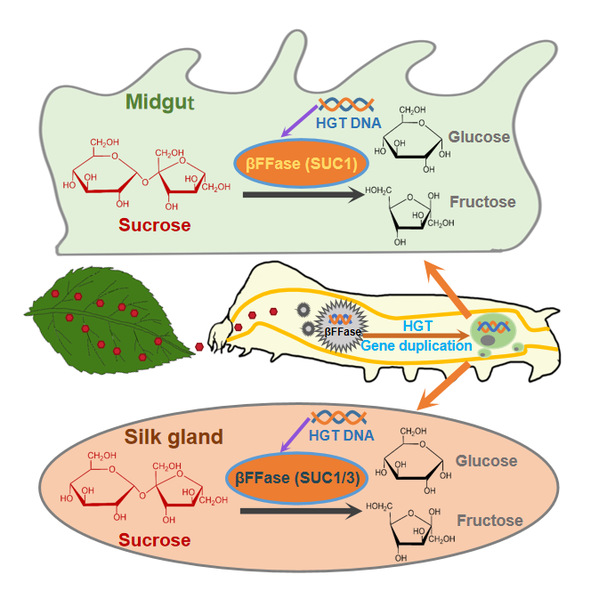Recently, the research team led by WANG Huabing from the Zhejiang University College of Animal Sciences published an open-access article entitled "Horizontal gene transfer and gene duplication of β-fructofuranosidase confer lepidopteran insects metabolic benefits" in the journal Molecular Biology and Evolution. This article analyzed the molecular evolution and functional differentiation of β-fructofuranosidase and revealed that lepidopteran insects can ingeniously regulate sucrose metabolism through horizontal gene transfer (HGT) and gene duplication in order to adapt to host plants and utilize sucrose components in food effectively.
Sucrose is a major product of photosynthesis and is the most commonly transported sugar in host plants, providing a rich source of carbon and energy for insect metabolism. There are about 200,000 species of lepidopteran insects worldwide, including moths and butterflies, most of which are the major pests of crops, vegetables and fruit trees. Previous studies by the research team found that lepidopteran insects contain a variety of specific sucrose enzymes, among which β-fructosidase (SUC) genes are diverse and have high enzymatic activities. And further studies revealed that lepidopteran insects acquired SUC genes from bacteria by horizontal gene transfer and then underwent gene duplication, gene loss and sequence mutation, resulting in the retention of different numbers of SUC genes in the genome of lepidopteran insects.

HGT is a potentially critical source of material for ecological adaptation and the evolution of novel genetic traits. Gene duplication is considered integral to the origin of novel traits because it offers raw genetic material for evolution and the subsequent generation of diverse biological functions. On the strength of comparative genomics, gene expression data and enzymatic analysis, this study found that SUC copies exhibited a clear divergence and underwent significant functional differentiation. To further verify the physiological functions of SUC genes, researchers performed CRISPR/Cas9 in silkworms and obtained different types of BmSUC1 homozygous mutants. They found that the mutants were viable but displayed delayed growth and reduced sucrase activities that included susceptibility to the sugar mimic alkaloid (1-deoxynojirimycin) found in high concentrations in mulberry. Therefore, this study demonstrated that lepidopteran insects acquired SUC genes from bacteria through HGT and thereby underwent gene duplication and functional differentiation, improving their adaptability and efficiency in food utilization, enhancing sucrose metabolism in the body, and promoting their own growth and development.
"This study provides a new theoretical basis for the systematic analysis of sucrose metabolism and energy supply in lepidopteran insects and offers new insights into beneficial insect utilization and pest control," said WANG Huabing.






